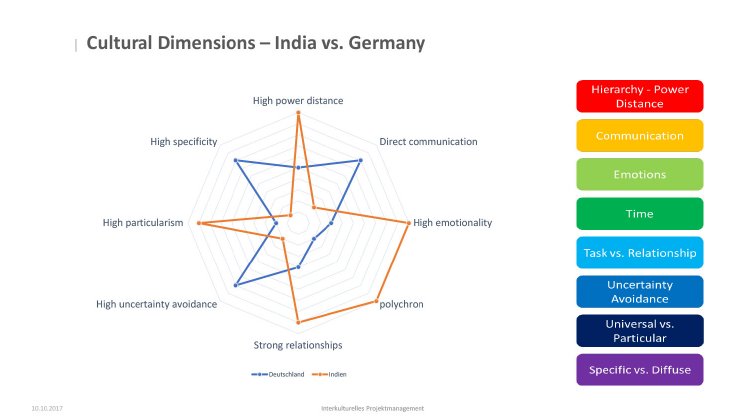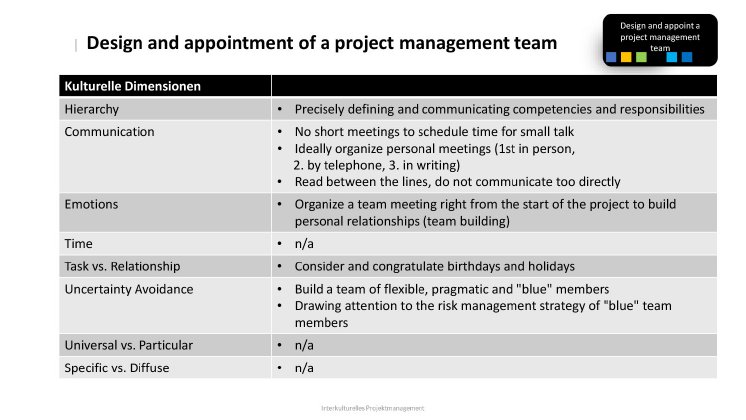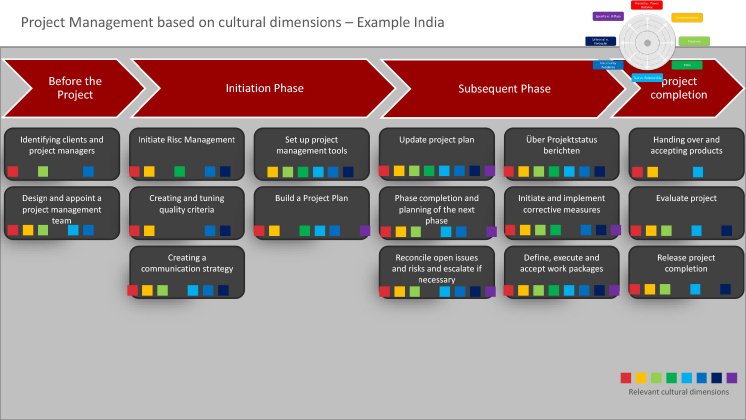The German and Indian cultural profile shows many differences and peculiarities, which can be subdivided into eight views according to Trompenaars, Hall and Hofstede. These are
- Hierarchy - Power Distance
- Communication
- Emotions
- time
- Task vs. Relationship
- Uncertainty Avoidance
- Universal vs. Particular
- Specific vs. Diffuse
The characteristics in each of these dimensions are completely different and have a decisive influence on the values and behaviour of the people of both countries. But what exactly is behind the respective cultural dimensions? And why do they have such an impact on everyday cooperation?
In the following, three of these cultural dimensions are described as examples and illustrated with a practical example from the cooperation with Indian colleagues.
CULTURAL DIMENSION: HIERARCHY - POWER DISTANCE
Description/definition according to Geert Hofstede: The degree of power distance expresses the willingness to accept unequal distribution of power in a society. A high value expresses the acceptance of the power imbalance, where people understand and accept "their place" in the system. Hierarchical structures are fully accepted. A small power distance, on the other hand, means that power is more evenly distributed. Looking at its cultural profile, India is one of the countries with a high power distance. The hierarchical thinking in India is therefore much more pronounced than in Germany.
The practical example: During a meeting between the on-site manager of the Indian provider and the staff of the German customer responsible for IT service management processes, discussions about the provider's performance take place. The German colleagues explain which services they expect, what weak points currently exist and how the contractually agreed services should be provided by the provider in the future.
From a German perspective, the discussion is initially very constructive and structured. This changes when the high-ranking Indian manager speaks out and vehemently rejects all criticism. The reasoning sounds absurd to German ears: He doesn't care what those present tell him, he only talks to managers of equal or higher hierarchical rank. Process owners have nothing to say to him.
With these words he leaves the room and immediately visits the German manager.
In the subsequent discussion, in which the process managers also take part, the German manager makes it clear that his employees speak for certain topics on his behalf and receive full competence and responsibility from him.
This clarification leads to the fact that in the future meetings will be much better, even with difficult topics, and the Indian manager will not see subordinates but equals in the individual colleagues.
CULTURAL DIMENSION: TIME
Description/definition according to Edward T. Hall: This dimension represents the differentiation between monochronous and polychronic cultures. Monochronous time means to pay attention to only one task per unit of time, while polychronous time means to be involved in several tasks at the same time. Monochronous cultures see time as a straight road, a line that can be divided into individual sections and planned. Time is a precious commodity that can be lost, won, saved or spent. Such people adhere strictly to plans and structures. Polychronic people, on the other hand, also like to do several things at the same time, as is typical for a cultural area. Polychronic people try to stick to plans and data just like monochronous people, but naturally they don't succeed with the same success.
The practical example: For the Indian project team members, it is difficult to understand why German project managers keep asking "Who does what up to when?
Most of the time it is still possible to quickly agree on the "what?", and the question "who?" is often referred to at least one team, rarely a single contact person, but the question "Until when?" leads to difficulties on a regular basis. With a lot of perseverance you get a statement about this or you have to make your own specifications. In our experience, however, this date is only a vague idea and not binding. On request on the given date, it is explained that it was not possible to work on the task because other things were taken care of. In other cases, results are delivered that do not meet the requirements. One explanation for this is that the German project manager is initially satisfied and the task will only be finalized with further iterations and discussions.
One solution that ensures easier cooperation and bridges the gap between the cultures is that the German project manager asks regularly and frequently (possibly several times a day) about the progress of the work packages. This makes the Indian colleague feel valued and reminds him of the urgency of the task and the German project manager can be sure that the task will be completed and will not be left unfinished due to other priorities or open questions.
CULTURAL DIMENSION: UNCERTAINTY AVOIDANCE
Description/definition according to Geert Hofstede: This dimension deals with the degree of threat that members of a society feel in an uncertain or unknown situation. A society with a high degree of uncertainty avoidance often views changes with skepticism. Such a company tries to limit and counteract uncertainties with rules and regulations. While Germany is one of the countries with a high degree of uncertainty avoidance, this dimension is low in India.
The practical example: In a pharmaceutical company, we are globally responsible for compliance in the IT infrastructure environment. From a German and US perspective, it is particularly important that all regulations and laws are observed. These specifications are very flexible for the Indian provider.
Within the scope of an internal audit, we have determined that an important step in the preparation of certain documentation has not been regularly carried out. For pharmaceutical companies, however, this is even prescribed by law. When we inform our Indian colleagues about this and remind them of the urgency of compliance, they are very surprised and tell us that they do not consider this step necessary. We can follow the explanations, but we do not give in, because the law has to be obeyed.
The Indian colleagues have a very simple solution for this: we should simply call the government so that they can amend the law and continue to work as before.
This example illustrates how different cultural understanding can be when dealing with rules and regulations.
OFFSHORE OUTSOURCING PROJECTS CAN BE EXPENSIVE WITHOUT INTERCULTURAL UNDERSTANDING
The anecdotes we have experienced in the course of various outsourcing projects illustrate that without mutual cultural understanding, great tensions can arise in cooperation. Many companies that have gone offshoring have come to the conclusion that a large part of the savings in wage costs can be lost through additional communication and management efforts. Reducing these process losses and improving intercultural cooperation are therefore of great economic importance for these companies.
Read the complete article on novum online, the Information platform of noventum consulting.




